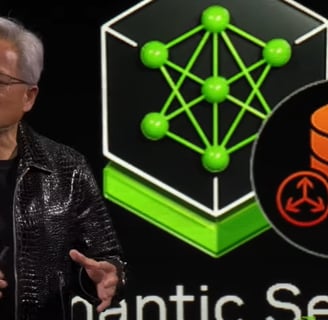Nvidia's Groundbreaking Innovations at CES 2025: Gaming Graphics and AI Advances
Nvidia has once again set the standard for video game graphics with the launch of its next-generation graphics chips at CES 2025. These new chips represent a significant leap forward in technology, incorporating advanced features that are poised to transform the gaming experience.
TECH REVIEWS


Nvidia has once again set the standard for video game graphics with the launch of its next-generation graphics chips at CES 2025. These new chips represent a significant leap forward in technology, incorporating advanced features that are poised to transform the gaming experience. The latest architecture not only increases performance but also enhances energy efficiency, a critical factor for both gamers and developers alike. With ray tracing capabilities becoming more accessible, these graphics chips bring photorealistic visuals to an even broader audience.
One of the standout features of this new lineup is the introduction of AI-driven image enhancement techniques. Utilizing deep learning, these chips can dynamically upscale lower resolution textures and improve frame rates during gameplay, delivering a smoother and more immersive experience. This innovation means that even older games can benefit from the enhanced capabilities, reviving interest in classic titles while simultaneously elevating modern releases. Furthermore, the new models are equipped with advanced cooling technologies that minimize thermal throttling, ensuring peak performance during intense gaming sessions.
Performance benchmarks from early tests demonstrate that these video game graphics chips significantly outperform their predecessors. Gamers can expect frame rates that soar to new heights, enabling smoother gameplay even in the most demanding environments. These enhancements also support higher resolutions, including 4K and beyond, allowing developers to create visually stunning worlds that were previously unattainable. The implications for developers are profound, as they now have the tools to push the boundaries of creativity and performance. With Nvidia's innovations, the gaming industry is on the brink of a new era, where visual fidelity and seamless gameplay become the norm rather than the exception.
AI Technologies: Accelerating Robot Development
At CES 2025, Nvidia's CEO Jensen Huang unveiled groundbreaking advancements in artificial intelligence, particularly in the context of robot development. The newly announced AI model technology is set to significantly enhance the training processes for robots across various industries. This innovative approach harnesses advanced algorithms and machine learning techniques to enable robots to learn more efficiently and effectively, allowing them to perform complex tasks with higher precision and reliability.
The core of this AI technology lies in its ability to simulate real-world environments, providing robots with rich datasets and realistic scenarios to improve their operational capabilities. By using a combination of 3D modeling, virtual reality, and intelligent feedback, this system allows robots to adapt to diverse situations and unstructured dynamics, which are crucial in fields like manufacturing, logistics, and healthcare. Such versatility in robot training is critical as industries strive to automate processes and increase efficiency.
Furthermore, the implications of these advancements extend beyond mere operational improvements. As AI technologies continue to evolve, they hold the potential to transform the landscape of robotics entirely. With the ability to teach robots new skills with minimal human intervention, organizations may soon witness lower training costs and reduced timeframes for deploying robotic systems. This leap forward may lead to greater adoption of robotic solutions in sectors such as agriculture, construction, and service industries, signaling a paradigm shift in how tasks are performed.
In the broader context of AI advancements, Nvidia's investment in robot training technology reflects a commitment to pushing the boundaries of what is possible. As robotics become more integrated into daily operations, the synergy between AI and robotics will likely foster innovations that could revolutionize productivity and reshape societal norms. The future of industries, catalyzed by these AI technologies, appears promising as we move into an era of advanced robotics.
The Future of Automotive Revenue: Nvidia's Growth Projections
Nvidia has positioned itself as a leader in automotive technology, showcasing its foresight in capitalizing on the evolving automotive landscape. With projections of automotive revenue reaching upwards of $5 billion by fiscal 2026, Nvidia's growth in this sector is largely influenced by strategic partnerships with key automotive manufacturers and continuous innovations in self-driving technology. As vehicles become more interconnected and automated, the demand for advanced graphics processing and AI capabilities is increasing, providing a lucrative market for Nvidia.
One significant factor driving this projected growth is Nvidia’s collaboration with major car manufacturers such as Tesla, Mercedes-Benz, and others. These partnerships not only enhance Nvidia's credibility in the automotive sector but also allow for the integration of advanced computing platforms like the Nvidia Drive platform. This platform has become integral to developing autonomous vehicle technology, enabling real-time data processing and machine learning applications that create safer and smarter driving experiences.
In addition to these partnerships, Nvidia is actively innovating in the self-driving domain. The company is investing heavily in its Drive Orin and Drive Hyperion platforms, which deliver unparalleled processing power required for autonomous vehicles. Such technological advancements ensure Nvidia remains at the forefront of the automotive tech market, as more manufacturers turn to AI-powered solutions for enhanced safety and efficiency. Furthermore, the growing trend towards electric vehicles will effectively expand Nvidia's customer base, as these vehicles rely heavily on sophisticated management systems that Nvidia excels in providing.
As the automotive industry continues its transition towards smart technologies, Nvidia is well-positioned to reap the benefits. Through its commitment to innovation and strategic alliances, Nvidia's automotive revenue is set to experience significant growth in the years to come, reinforcing its status as a pivotal player in this competitive market.
CES 2025: A Summary of Key Takeaways from Nvidia's Keynote
The Consumer Electronics Show (CES) 2025 was marked by significant announcements from Nvidia, which firmly established the company's commitment to leading technological advancements in the gaming and artificial intelligence sectors. During his keynote address, Jensen Huang, the CEO of Nvidia, highlighted a series of innovations that promise to redefine the landscape of digital experiences and automation. Key among these was the unveiling of the next-generation graphics processing units (GPUs), designed to deliver unprecedented performance while utilizing advanced AI capabilities.
One of the pivotal themes from Huang's speech was the emphasis on enhancing gameplay experiences through AI-driven technologies. With the introduction of new GPU architectures, Nvidia aims to enhance real-time rendering and improve the efficiency of graphics in gaming. The inclusion of machine learning techniques in graphics rendering ability is anticipated to significantly decrease latency, allowing gamers to enjoy more fluid and immersive experiences. This progress not only reinforces Nvidia's dominance in the gaming industry but also sets a precedent for future gaming technologies.
Furthermore, Huang's talk encompassed Nvidia's vital role in the automotive landscape, where AI is increasingly becoming integral to advancements in autonomous driving technology. Nvidia's datacenters are developing sophisticated neural networks capable of processing vast amounts of data from vehicles in real-time. This innovation demonstrates Nvidia's strategic commitment to not just stay relevant in gaming but also shape the future of transportation with AI solutions that promise safety and efficiency.
In conclusion, the insights from Nvidia’s keynote at CES 2025 exhibit a clear vision for the company's trajectory. The amalgamation of AI capabilities with gaming technology illustrates Nvidia's aim to create next-generation products that resonate across multiple industries, ensuring a robust presence in the evolving tech narrative. As these innovations unfold, they are poised to influence both consumer experiences and industrial functionalities significantly.
